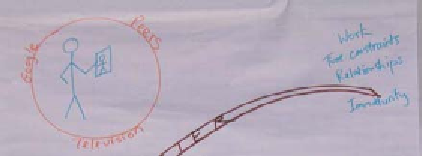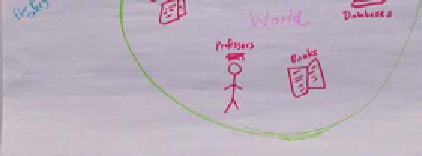Information Technology Reference
In-Depth Information
Figure 2. Rich picture of student processes
In building upon baseline phenomenographic
findings, librarians decided to adopt a radically
different approach as they continued their finding
out process. They asked computer science profes-
sors teaching Human-Computer Interaction (HCI)
courses to invite their students to assume respon-
sibilities for problem definition, methodological
implementation, and data analysis. This proved
to be a fortuitous decision: from 2004 to 2006,
reliance on student-framed, student-conducted,
and student-reported research results produced
rich evidence about different types of students,
their information use at various stages—and why
this is so, and their learning style and delivery
media preferences.
user-Centered ProjeCts
Enabled by SSM thinking tools, librarians worked
with students over a three year period to (re)design
several digital initiatives, including an academic
research guide, a digital research portal, and a
website persona prototype. In keeping with their
commitment to learn from students about students,
librarians relinquished control of the research
process: students were supervised by their profes-
sors as they generated problem definitions, chose
research methodologies, conducted data analysis,
and reported research results.
Students' initial research explored: “What do
Cal Poly students know about library resources?
What do they want to know? And how do they
want to learn it?” Students employed a variety of
quantitative and qualitative methods to obtain a
rich profile of student behaviors. For instance,
they conducted interviews, administered paper
and pencil surveys, facilitated focus groups, and
implemented usability tests. Results revealed that
seventy-two percent of student respondents used
the Internet for research while only four percent
reported using the library. Given the Net Genera-
tion's Web usage patterns, student researchers
advised librarians to improve their digital dis-
transition students from 'where they were' to
'where they needed to be' upon graduation. Their
growing appreciation for students' rich interac-
tions with (nonacademic) information sources
prompted librarians to build—in a constructiv-
ist fashion—upon students' prior learning. This
required identifying the ways in which students
use information within different disciplines and at
different stages—from first to final year of study.
Known as 'relational information literacy', this
approach recommends that domain knowledge
advance concurrently with information profi-
ciencies (Bruce, 1997b). Finally, given students'
usage of the Internet, librarians recognized that
they needed to enhance librarian and library
web presence. Hence, in this instance, the Rich
Picture technique was used to illustrate student
perspectives on information search and retrieval
and on library services, and the action outcome of
the subsequent debate was to continue to explore
student behavior with the purpose of finding ways
to better serve their needs.



Search WWH ::

Custom Search